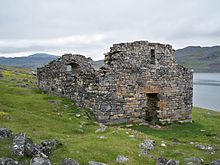
Romanesque architecture is an architectural style of medieval Europe that was predominant in the 11th and 12th centuries. The style eventually developed into the Gothic style with the shape of the arches providing a simple distinction: the Romanesque is characterized by semicircular arches, while the Gothic is marked by the pointed arches. The Romanesque emerged nearly simultaneously in multiple countries ; its examples can be found across the continent, making it the first pan-European architectural style since Imperial Roman architecture. Similarly to Gothic, the name of the style was transferred onto the contemporary Romanesque art.
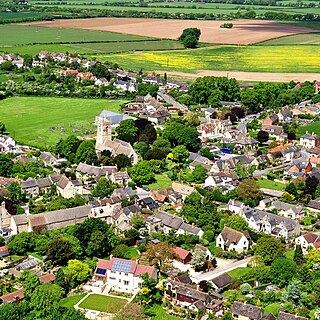
Oxfordshire is a ceremonial county in South East England. The county is bordered by Northamptonshire and Warwickshire to the north, Buckinghamshire to the east, Berkshire to the south, and Wiltshire and Gloucestershire to the west. The city of Oxford is the largest settlement and county town.

The Cloisters, also known as the Met Cloisters, is a museum in the Washington Heights neighborhood of Upper Manhattan, New York City. The museum, situated in Fort Tryon Park, specializes in European medieval art and architecture, with a focus on the Romanesque and Gothic periods. Governed by the Metropolitan Museum of Art, it contains a large collection of medieval artworks shown in the architectural settings of French monasteries and abbeys. Its buildings are centered around four cloisters—the Cuxa, Saint-Guilhem, Bonnefont and Trie—that were acquired by American sculptor and art dealer George Grey Barnard in France before 1913, and moved to New York. Barnard's collection was bought for the museum by financier and philanthropist John D. Rockefeller Jr. Other major sources of objects were the collections of J. P. Morgan and Joseph Brummer.

The term Norman architecture is used to categorise styles of Romanesque architecture developed by the Normans in the various lands under their dominion or influence in the 11th and 12th centuries. In particular the term is traditionally used for English Romanesque architecture. The Normans introduced large numbers of castles and fortifications including Norman keeps, and at the same time monasteries, abbeys, churches and cathedrals, in a style characterised by the usual Romanesque rounded arches and especially massive proportions compared to other regional variations of the style.

The Convent of Christ is a former Catholic convent in Tomar, Portugal. Originally a 12th-century Templar stronghold, when the order was dissolved in the 14th century the Portuguese branch was turned into the Knights of the Order of Christ, that later supported Portugal's maritime discoveries of the 15th century. The convent and castle complex are a historic and cultural monument and was listed as a UNESCO World Heritage site in 1983.

Pre-Romanesque art and architecture is the period in European art from either, the emergence of the Merovingian kingdom in about 500 AD or from the Carolingian Renaissance in the late 8th century, to the beginning of the 11th century Romanesque period. The term is generally used in English only for architecture and monumental sculpture, but here all the arts of the period are briefly described.

Cistercian architecture is a style of architecture associated with the churches, monasteries and abbeys of the Roman Catholic Cistercian Order. It was heavily influenced by Abbot Bernard of Clairvaux, who believed that churches should avoid superfluous ornamentation so as not to distract from prayer. Cistercian architecture was simple and utilitarian. Although a few images of religious subjects were allowed, such as the crucifix, elaborate figures common in medieval churches were prohibited. Bernard noted their capacity for distracting monks in a famous letter. Early Cistercian architecture shows a transition between Romanesque and Gothic architecture. Later abbeys were constructed in Renaissance and Baroque styles, which were more ornate by nature.

Rolduc is the name of a medieval abbey located on the edge of the town of Kerkrade in the far south-east of the Netherlands. It is today a Roman Catholic seminary with an affiliated conference center. The abbey is a rijksmonument. It features on the official list of 100 top Dutch heritage sites, drawn up in 1990 by what is today the Rijksdienst voor het Cultureel Erfgoed.

St. Bernard de Clairvaux Church is a medieval Spanish monastery cloister which was built in the town of Sacramenia in Segovia, Spain, in the 12th century but dismantled in the 20th century and shipped to New York City in the United States. It was eventually reassembled at 16711 West Dixie Highway, North Miami Beach, Florida, where it is now an Episcopal church and tourist attraction called Ancient Spanish Monastery.
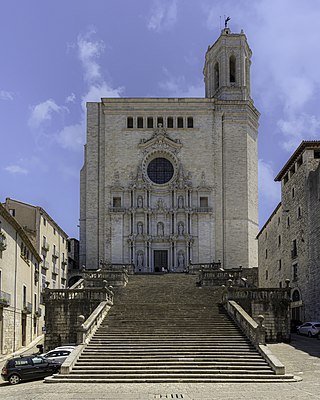
Girona Cathedral, also known as the Cathedral of Saint Mary of Girona, is a Roman Catholic church located in Girona, Catalonia, Spain. It is the seat of the Roman Catholic Diocese of Girona. The cathedral's interior includes the widest Gothic nave in the world, with a width of 23 metres (75 ft), and the second-widest of any church after that of St. Peter's Basilica. Its construction was begun in the 11th century in the Romanesque architectural style, and continued in the 13th century in the Gothic style. Of the original Romanesque edifice only the 12th-century cloister and a bell tower remain. The second bell tower was completed in the 18th century.

The Abbey of Fontenay is a former Cistercian abbey located in the commune of Marmagne, near Montbard, in the département of Côte-d'Or in France. It was founded by Saint Bernard of Clairvaux in 1118, and built in the Romanesque style. It is one of the oldest and most complete Cistercian abbeys in Europe, and became a UNESCO World Heritage Site in 1981. Of the original complex comprising church, dormitory, cloister, chapter house, caldarium, refectory, dovecote and forge, all remain intact except the refectory and are well maintained. The Abbey of Fontenay, along with other Cistercian abbeys, forms a connecting link between Romanesque and Gothic architecture.

Portuguese Gothic architecture is the architectural style prevalent in Portugal in the Late Middle Ages. As in other parts of Europe, Gothic style slowly replaced Romanesque architecture in the period between the late 12th and the 13th century. Between the late 15th and early 16th century, Gothic was replaced by Renaissance architecture through an intermediate style called Manueline.
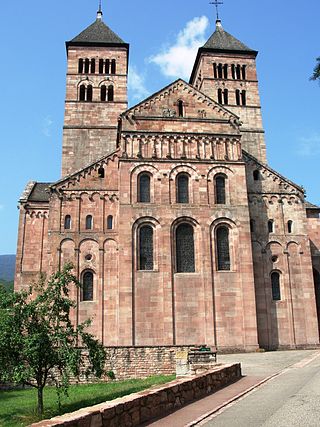
The Route Romane d'Alsace is a tourist itinerary designed by the Association Voix et Route Romane to link both the well-known and the more secret examples of Romanesque architecture of Alsace, in an itinerary of 19 stages, linking churches, abbeys and fortresses, that range from the first Romanesque structures of Alsace at the abbey church of Saint Trophime, Eschau, into the 13th century, and the beginning of Gothic architecture in Alsace. From north to south, the Route Romane d'Alsace traverses the Bas-Rhin and the Haut-Rhin, passing through:

Saint-Génis-des-Fontaines Abbey is a Benedictine abbey in Saint-Génis-des-Fontaines, Pyrénées-Orientales, France. It was dedicated to Saint Genesius and Saint Michael, to whom the surviving church is still dedicated.

Romanesque architecture is an architectural style of medieval Europe characterised by semi-circular arches. The term "Romanesque" is usually used for the period from the 10th to the 12th century with "Pre-Romanesque" and "First Romanesque" being applied to earlier buildings with Romanesque characteristics. Romanesque architecture can be found across the continent, diversified by regional materials and characteristics, but with an overall consistency that makes it the first pan-European architectural style since Imperial Roman Architecture. The Romanesque style in England is traditionally referred to as Norman architecture.

Moissac Abbey was a Benedictine and Cluniac monastery in Moissac, Tarn-et-Garonne in south-western France. A number of its medieval buildings survive including the abbey church, which has a famous and important Romanesque sculpture around the entrance.
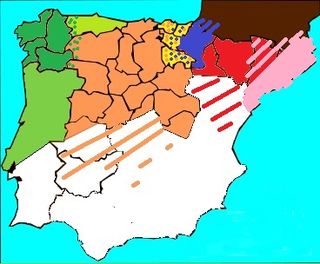
Spanish Romanesque designates the Romanesque art developed in the Hispanic-Christian kingdoms of the Iberian Peninsula in the 11th and 12th centuries. Its stylistic features are essentially common to the European Romanesque although it developed particular characteristics in the different regions of the peninsula. There is no Romanesque art in the southern half of the peninsula because it remained under Muslim rule (Al-Andalus). The examples of Romanesque buildings in the central area of the peninsula are sparse and of the latest period, with virtually no presence south of the Ebro and the Tagus. Most Romanesque buildings can be found in the northern third of the peninsula. Romanesque art was introduced into the peninsula from east to west, so scholars have usually defined regional characteristics accordingly: the "eastern kingdoms" comprising the Pyrenean areas, Catalan Romanesque, Aragonese Romanesque and Navarrese Romanesque, and the "western kingdoms" comprising Castilian-Leonese Romanesque, Asturian Romanesque, Galician Romanesque and Portuguese Romanesque.

The Romanesque style of architecture was introduced in Portugal between the end of the 11th and the beginning of the 12th century. In general, Portuguese cathedrals have a heavy, fortress-like appearance, with crenellations and few decorative elements apart from portals and windows. Portuguese Romanesque cathedrals were later extensively modified, among others the Old Cathedral of Coimbra, although it only had some minor changes.

Romanesque architecture appeared in France at the end of the 10th century, with the development of feudal society and the rise and spread of monastic orders, particularly the Benedictines, which built many important abbeys and monasteries in the style. It continued to dominate religious architecture until the appearance of French Gothic architecture in the Île-de-France between about 1140 and 1150.

Gothic cathedrals and churches are religious buildings created in Europe between the mid-12th century and the beginning of the 16th century. The cathedrals are notable particularly for their great height and their extensive use of stained glass to fill the interiors with light. They were the tallest and largest buildings of their time and the most prominent examples of Gothic architecture. The appearance of the Gothic cathedral was not only a revolution in architecture; it also introduced new forms in decoration, sculpture, and art.
